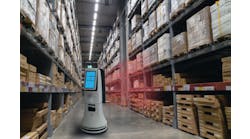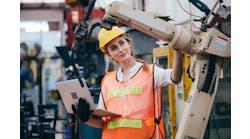By David Chen, CTO and co-founder of Orbbec
The use of 3D technology isn’t new in manufacturing. Organizations that produce products that are mission- or life-critical—think aerospace—have been using 3D-measurement tools for product inspections and material-quality control for decades. When so much depends on product reliability, organizations have been willing to invest in advanced technology, extensive worker training, and lengthier production time to ensure components are manufactured to the highest quality standards.
Over the years, breakthroughs have made 3D technology more accessible and affordable, and now machine intelligence is reducing the need for extensive worker training. Some early adopters in the manufacturing space have taken advantage of these developments and applied 3D applications to upgrade quality control and expand the capabilities of robotics systems used in production, like robots that move heavy objects, complete repetitive tasks or perform functions in hazardous environments.
The same technologies can improve quality, accelerate production and keep workers safer in many more manufacturing processes, but truly widespread adoption of 3D applications has been delayed because of concerns about the cost. AI is also poised to accelerate the use of 3D technology over the next decade by lowering worker training requirements and expanding machine capabilities. This is what a development manufacturer should monitor closely so they can stay competitive.
3D technology applications in manufacturing
Today, 3D technology is frequently used for testing in manufacturing, and testing applications generally fall into two categories: non-contact testing (typically conducted using a 3D camera), and contact 3D technology in the form of a probe. Currently, some manufacturers use 2D or 3D cameras during production as a non-contact testing tool to ensure components or products meet specifications, then they conduct tests on a smaller sample using a 3D probe to get more accurate results.
Manufacturers who use this technique include companies that make components for automobiles. The contact tests take longer and require more advanced training for workers who operate the testing tools, so manufacturers conduct the contact tests on a small portion of the total number of components created. Other sectors, including aerospace, use advanced contact testing tools that incorporate 3D technology to control factors like material quality during production.
As AI reduces the cost and time required for worker training and 3D modeling, more manufacturing organizations will leverage 3D tools to improve accuracy and product quality, including manufacturers who make consumer goods. In the next five to 10 years, using 3D technologies to make manufacturing processes smarter will become table-stakes for many different types of organizations, and manufacturers who don’t adopt it risk being left behind as competitors modernize.
Robotics will benefit from a 3D technology revolution
As the use of 3D technology in manufacturing expands, robotics will be a primary beneficiary. Industrial robotics systems are already used in automated manufacturing settings for tasks like picking components from bins on production lines, and manufacturers can invest in 3D components to make these processes smarter. For example, 3D technology can enable robotic arms to choose components more quickly and accurately and place components precisely to accelerate the next assembly step.
Industrial robotics systems with 3D cameras onboard can scan from multiple perspectives while in motion without distortions from blurring, ambient light, or vibrations. This clearer view of the production environment in real-time enables industrial robots to navigate to the next step in an assembly process efficiently, expanding the roles industrial robots can play in automated manufacturing settings.
The use of dexterous robotic systems that automate repetitive pick-and-pack tasks in warehouses is another example of how 3D applications can enable smarter processes. Equipped with 3D cameras, industrial robots can now handle a variety of package sizes and packaging materials (e.g., bags, boxes, etc.) and stack packages on pallets in configurations that maximize efficiency. 3D camera- and sensor-equipped robots can also maintain environmental awareness and function independently, taking actions like pausing for conveyor-line blockages without human intervention.
Faster, safer, smarter manufacturing
These examples demonstrate how 3D technologies are helping manufacturers complete processes more quickly, keep workers safer, and make existing robotics smarter. With the advancements in AI and machine learning making robotics systems more autonomous and user-friendly, organizations don’t have to invest as much in training workers to intervene for exceptions, or preprogram systems to handle new configurations, as is the case with many conventional robotics currently used in manufacturing.
Startup manufacturers who are setting up production lines are now recognizing they can use 3D technology to create a competitive advantage. Robotics systems powered by intelligent software and equipped with high-performance 3D cameras and sensors can enable faster, safer and smarter manufacturing, and this next-generation improvement on traditional methods can provide an edge for manufacturers who are competing with established rivals who still use conventional technologies.
Over the next several years, leaders of manufacturing operations that still use older equipment should keep an eye on the future and consider retooling. Conventional technologies that successfully supported production lines in the past will soon be outmatched by 3D technologies that make manufacturing processes smarter. It’s time for an upgrade.



